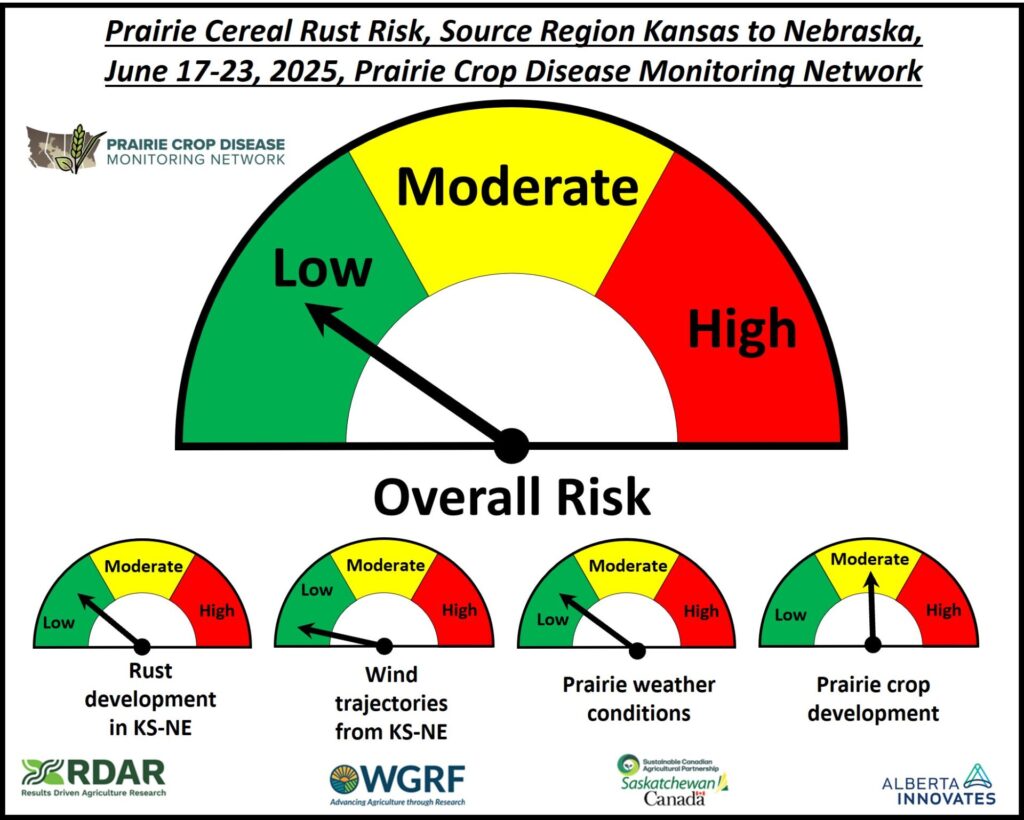The seventh weekly Prairie Crop Disease Monitoring Network (PCDMN) Prairie wind trajectory cereal rust risk report for 2025 is available for download now at the following link: June 17-23, 2025.
General weather and crop conditions
- Prairie winter wheat crops are generally moving into the post-heading and grain filling growth stages, while much of the spring wheat crop is ranging from the tillering to stem elongation and flag leaf emergence, with some early planted crops moving into head emergence.
- Temperatures have been somewhat higher than normal for most of the Prairie region since April 1, 2025, and from June 16-22, 2025 temperatures have ranged from around 10 to 20°C. These temperatures are generally not conducive to leaf and stem rust development, although cooler temperatures are more conducive for stripe rust versus leaf and stem rust.
- Growing season rainfall for the Prairie region has been generally drier than normal. Recent rainfall in some areas the Prairies could potentially have washed rust spores from the air and into wheat crops, especially winter wheat, while also resulting in canopy moisture conditions that may favour infection and further rust development.
Pacific Northwest and Montana
- There were moderate numbers of reverse wind trajectories that passed over the PNW region and into the prairies from June 16-23, 2025. Although, stripe rust development continues, it is generally lower versus 2024. Overall, as of June 26, 2025 the risk of stripe rust appearance from the PNW is generally low and scouting for this disease in the Prairie region is generally not urgent. However, Prairie locations with three or more trajectories may be at somewhat higher risk. The late development and low levels of stripe rust in commercial PNW fields has had an overall dampening effect on the rust risk from the PNW
- However, the recent detection of stripe rust in research plots at multiple locations in Montana brings the stripe rust issue adjacent to the Prairie region. These observations bring the stripe rust problem much closer to southern Alberta and southern Saskatchewan and could represent a regional source of this disease
- An assessment of the number of reverse trajectories for at risk Prairie locations was done for air parcels that previously moved over Montana from June 17-23, 2025
- A total of 114 trajectories for 35 locations passed over Montana and ended up in the Prairie region
- SWIFT CURRENT, SK had a total of six trajectories from June 17-23, 2025, while BEISEKER, CALGARY, LETHBRIDGE, MEDICINE HAT, OLDS, PROVOST, and VULCAN, AB, GAINSBOROUGH and WEYBURN, SK, and ARBORG, MB each had five trajectories
- NAICAM and YORKTON, SK, and CARMAN and RUSSELL, MB each had four trajectories that previously passed over Montana
- LACOMBE, AB, GRENFELL, KINDERSLEY, REGINA, UNITY and WATROUS, SK, and PORTAGE and SELKIRD, MB each had three trajectories from Montana, while the remaining 11 locations had 1-2 trajectories from Montana
- Prairie wheat growers in these areas, especially where >=three trajectories occurred from Montana, are encouraged to be on the look out for symptoms of stripe rust, especially in fields planted to susceptible to moderately susceptible varieties. For information on cereal variety reactions for stripe rust, please consult your Provincial variety guides:
- An assessment of the number of reverse trajectories for at risk Prairie locations was done for air parcels that previously moved over Montana from June 17-23, 2025

Kansas/Nebraska
- There was a low number of wind trajectory events from the KS/NE region from June 10-16, 2025. Overall, as of June 26, 2025 the risk of stem, leaf, stripe, and crown rust appearance from the Kansas-Nebraska corridor is generally limited and scouting for these diseases in the Prairies is not urgent
- However, continuing rust (mainly stripe rust) observations and further development, especially in Nebraska, may increase the risk, while the detection of stripe rust in research plots in Wisconsin brings the stripe rust issue closer to the Prairie region.


